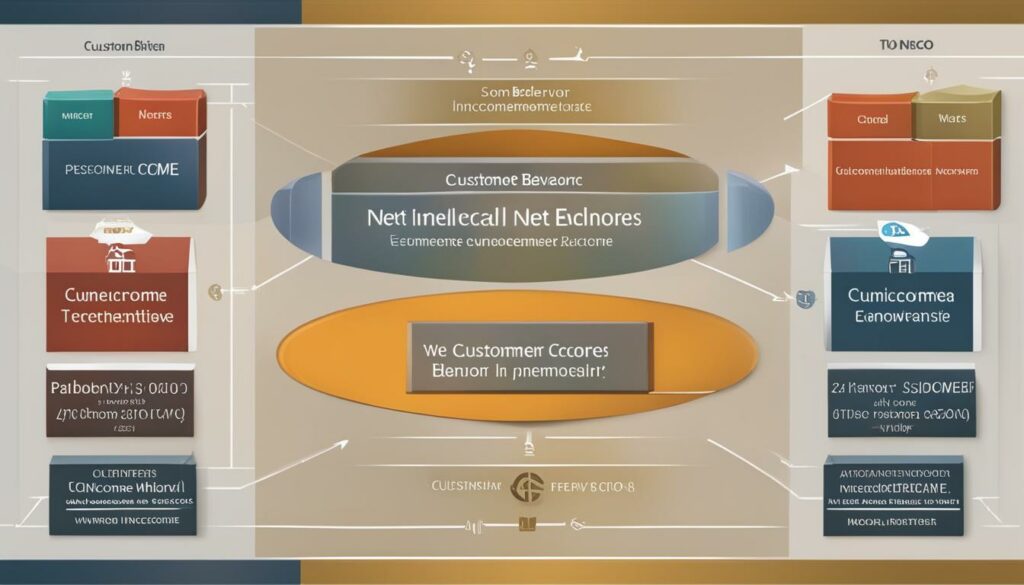Net income is a crucial metric for evaluating the financial performance and profitability of an ecommerce business. It is the profit that remains after deducting all expenses, including taxes, from the total revenue generated by the business. Often referred to as the “bottom line,” net income is the last line on the income statement, showcasing the business’s overall financial health.
To calculate net income, ecommerce businesses use either a single-step or multistep income statement, depending on the complexity of their operations. This metric provides valuable insights into a business’s earnings and indicates its long-term viability.
Key Takeaways:
- Net income is the profit that remains after deducting all expenses, including taxes, from the total revenue.
- It is an important measure of profitability and indicates the financial health and long-term viability of an ecommerce business.
- Net income is calculated using an income statement, which can be either a single-step or multistep format.
- Understanding net income is essential for owners, lenders, and investors in making informed decisions related to growth and investment.
- Ecommerce businesses can employ various strategies to improve net income, such as optimizing costs, increasing average order value, and focusing on operational excellence.
Importance of Net Income in Ecommerce
In ecommerce, net income holds significant importance in evaluating the financial health and long-term viability of a business. It serves as a crucial metric that provides insights into the profitability of the business and reflects the amount of money generated after deducting all expenses. Net income is not only expressed as a dollar figure but is also represented as a percentage, known as the net profit margin. This metric is utilized by business owners, lenders, and investors to assess the performance of the ecommerce enterprise and make informed decisions regarding growth, investment, and profit distribution.
By analyzing the net income, stakeholders can gain a comprehensive understanding of the financial well-being of the ecommerce business. It enables them to gauge the profitability of the organization and assess its ability to generate sustainable earnings. Additionally, net income is a key parameter for measuring the success of business strategies and identifying areas for improvement.
“Net income serves as a compass for businesses, guiding them towards effective decision-making and long-term profitability.”
One of the crucial uses of net income is determining the financial health of an ecommerce company. A healthy net income indicates that the business is capable of generating profits consistently, covering expenses, and generating surplus for future growth. It reflects the ability of the business to sustain its operations, repay debts, and invest for expansion.
Moreover, net income is directly related to the profitability of an ecommerce business. A higher net income highlights a greater level of profitability and showcases the success of the business in generating revenue and minimizing expenses. It serves as a measure of efficiency and effectiveness in utilizing available resources to maximize profits.
When evaluating the long-term viability of an ecommerce venture, net income plays a crucial role. It provides insights into the financial sustainability of the business, indicating whether it is capable of surviving and thriving in the competitive market. Net income helps in assessing the potential risks and rewards associated with investment decisions, enabling stakeholders to make informed choices regarding the allocation of resources.
The net profit margin, a percentage derived from net income, is another vital aspect in evaluating the profitability of an ecommerce business. It measures the proportion of each dollar of revenue that translates into net income. A higher net profit margin indicates greater efficiency in managing expenses and generating profits, portraying the financial strength and profitability of the business.
Calculating Net Profit Margin
The net profit margin can be calculated using the following formula:
| Net Profit Margin | Formula |
|---|---|
| Net Profit Margin | Net Income / Total Revenue |
“Net profit margin acts as a measure of the efficiency and profitability of an ecommerce business, showcasing its ability to generate earnings from every dollar of revenue.”
Understanding the importance of net income and the net profit margin is vital for stakeholders in the ecommerce industry. It allows them to assess the financial health, profitability, and long-term viability of the business, facilitating sound decision-making for sustainable growth and success.

Calculating Net Income in Ecommerce
In ecommerce, calculating net income involves subtracting all expenses, including taxes, from the total revenue of the business. This process provides a comprehensive understanding of the profit generated by the ecommerce venture. The calculation encompasses deducting the cost of goods sold (COGS), operating expenses, and any other relevant expenditures incurred by the business.
Net income is a crucial metric as it reflects the actual profitability of the ecommerce business, taking into account all expenses and taxes. It presents a clear picture of the financial performance and viability of the enterprise.
Determining Total Revenue
To determine the total revenue, it is essential to consider all the sources of income generated by the ecommerce business. This includes revenue from sales, subscriptions, advertising, and any other sources of income specific to the organization.
For example, an ecommerce business may earn revenue from product sales, third-party advertising on their website, and premium subscription services. The total revenue is the sum of all these income streams.
Calculating Expenses
Expenses in ecommerce encompass the cost of goods sold (COGS), operating expenses, taxes, and any other relevant financial obligations. It is important to identify and categorize these expenses accurately to calculate net income effectively.
The cost of goods sold (COGS) includes the direct costs associated with producing or procuring the products sold by the ecommerce business. This typically includes the cost of raw materials, manufacturing, shipping, and any other costs directly related to product creation and delivery.
Operating expenses, on the other hand, cover the day-to-day costs of running the ecommerce business. These can include marketing and advertising expenses, employee salaries, rent, utilities, and any other operational costs necessary to maintain the business.
In addition to COGS and operating expenses, taxes are a significant component of calculating net income. Businesses must account for any tax obligations, including income tax, sales tax, and other applicable taxes.
The Formula for Net Income
Once the total revenue and expenses are determined, calculating net income is straightforward. It involves subtracting the total expenses from the total revenue, as shown in the following formula:
Net Income = Total Revenue – Total Expenses
The resulting net income provides a comprehensive view of the profit generated by the ecommerce business, accounting for all expenses and taxes.
An Example Calculation
Let’s consider a hypothetical ecommerce business that generated $500,000 in total revenue in a given year. The business had $300,000 in COGS, $100,000 in operating expenses, and $50,000 in taxes.
Using the formula above, we can calculate the net income as follows:
Net Income = $500,000 (Total Revenue) – $300,000 (COGS) – $100,000 (Operating Expenses) – $50,000 (Taxes)
Net Income = $50,000
Based on this calculation, the net income of the ecommerce business for that year is $50,000.

Strategies to Improve Net Income in Ecommerce
Improving net income in ecommerce requires implementing effective strategies that focus on maximizing profitability. By optimizing various aspects of the business, such as pricing, cost management, and average order value, ecommerce businesses can significantly enhance their net income.
1. Pricing Premium Products or Services
One strategy to improve net income is by charging a premium for products or services. By conducting market research and analyzing customer preferences, ecommerce businesses can identify unique selling points and position their offerings as high-value products. Implementing dynamic pricing strategies can also help capture higher margins and increase net income.
2. Cost Optimization through Supplier Negotiations
To improve net income, ecommerce businesses should focus on optimizing costs. This can be achieved by negotiating better rates with suppliers, leveraging economies of scale, and exploring alternative sourcing options. By strategically managing supplier relationships, businesses can reduce procurement costs and enhance their profit margins.
3. Increasing Average Order Value
Increasing the average order value is another effective strategy to improve net income. Businesses can implement tactics such as offering product bundles, upselling complementary items, and setting minimum order quantities. By encouraging customers to spend more per transaction, ecommerce businesses can boost their revenue and ultimately enhance net income.
4. Streamlining Operations for Efficiency
Focusing on operational excellence is crucial for improving net income. By optimizing and automating various processes, businesses can minimize costs, reduce errors, and increase overall efficiency. This includes streamlining inventory management, order fulfillment, and customer service operations to maximize productivity and profitability.

Effective strategies to improve net income in ecommerce include pricing premium products, optimizing costs through supplier negotiations, increasing average order value, and streamlining operations for efficiency.
By implementing these strategies, ecommerce businesses can effectively improve their net income and drive long-term financial success. It is crucial to continuously evaluate and adjust these strategies based on market trends, customer preferences, and business goals to maintain profitability and sustainable growth.
Customer Behavior and Net Income in Ecommerce
Customer behavior plays a significant role in determining the net income of ecommerce businesses. Understanding and leveraging customer behavior can help businesses optimize pricing strategies, purchasing decisions, and average order value, ultimately leading to higher net income and revenue growth.
Influencing Purchasing Decisions through Pricing
Pricing is a critical factor that directly impacts customer purchasing decisions. By analyzing customer behavior and preferences, ecommerce businesses can set optimal prices that maximize net income. Through market research and competitor analysis, businesses can identify the price range that aligns with their target audience’s willingness to pay. This information can be leveraged to set competitive prices that attract customers while still ensuring profitability.
“Understanding the customer’s perception of value is key to setting the right price for your products or services.”
Optimizing Average Order Value
Increasing the average order value is another effective strategy for improving net income in ecommerce. By understanding customer buying patterns and behavior, businesses can implement strategies that encourage customers to spend more during each transaction. Tactics such as offering product bundles, upselling, and cross-selling can help increase the average order value and consequently boost net income.
Enhancing Customer Experience
Providing a seamless and personalized shopping experience can significantly impact customer behavior and drive revenue growth. By leveraging customer data and utilizing customer relationship management (CRM) systems, businesses can tailor their marketing efforts and product recommendations to each individual customer. This personalization creates a sense of trust and loyalty, increasing the likelihood of repeat purchases and higher net income.
It is important for ecommerce businesses to continuously monitor and refine their understanding of customer behavior. Regular analysis of customer data, qualitative feedback, and market trends can provide valuable insights that inform pricing strategies, optimize purchasing decisions, and maximize average order value. By aligning their business strategies with customer behavior, ecommerce businesses can drive sustainable growth and improve net income.
| Customer Behavior Insights | Impact on Net Income |
|---|---|
| Understanding price sensitivity | Optimized pricing strategies |
| Identifying buying patterns | Improved average order value |
| Delivering personalized experiences | Increased customer loyalty |

By leveraging customer behavior insights, ecommerce businesses can make informed decisions that positively impact net income. From strategic pricing to optimizing the customer experience, understanding customer behavior is essential for driving profitability and sustainable growth in the competitive ecommerce landscape.
Net Income and its Relation to Other Metrics in Ecommerce
When it comes to evaluating the financial performance of an ecommerce business, net income is a crucial metric. However, it is closely tied to other important metrics such as profit margin, gross profit, operating profit, revenue, and expenses.
Gross profit is the profit generated after deducting the cost of goods sold (COGS) from the revenue, but before factoring in other expenses. This metric provides insight into the efficiency of the business’s core operations.
Operating profit goes a step further by considering both COGS and operating expenses. It provides a comprehensive view of the business’s profitability and its ability to manage costs.
Net income, on the other hand, takes into account all revenue and deducts all expenses, including taxes. It is the bottom line, the ultimate measure of the business’s profitability after all financial transactions have been considered.
These metrics are interconnected and offer different perspectives on the financial performance of an ecommerce business. While gross profit and operating profit focus on specific aspects, net income provides a holistic view of the business’s profitability. Understanding these metrics and their relation to net income is essential for making informed decisions about the financial health and growth potential of an ecommerce business.
FAQ
What is net income in ecommerce?
Net income in ecommerce is the profit a business makes after deducting all expenses, including taxes, from its total revenue.
Why is net income important in ecommerce?
Net income is important in ecommerce because it provides insights into the profitability and financial health of the business, helping to assess its long-term viability.
How is net income calculated in ecommerce?
Net income in ecommerce is calculated by subtracting all expenses, including taxes, from the total revenue of the business.
What strategies can be used to improve net income in ecommerce?
Strategies to improve net income in ecommerce include increasing prices, optimizing costs, increasing the average order value, and focusing on operational excellence.
How does customer behavior impact net income in ecommerce?
Customer behavior, such as pricing preferences and purchasing decisions, can significantly impact net income in ecommerce. Understanding and catering to customer preferences can help maximize net income.
How is net income related to other metrics in ecommerce?
Net income is closely related to other metrics in ecommerce, such as profit margin, gross profit, and operating profit. These metrics provide different perspectives on the business’s financial performance.
